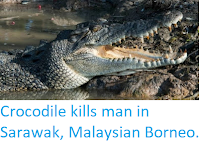The Zoological Society of London has announced the discovery of a new population of Gharials, Gavialis gangeticus, in the Bardia National Park in Nepal. The population was discovered by conservationists from the society and Biodiversity Conservancy Nepal in June 2019, though the discovery has only been announced this week. Gharials are considered to be Critically Endangered under the terms of the
International Union for the Conservation of Nature’s Red List of ThreatenedSpecies, with less than a thousand individuals left in the wild, in five breeding populations scattered across India, Bangladesh, and Nepal. Until this year Gharials had not been seen in the Bardia National Park for around 30 years, with the only known population in Nepal being in the Chitwan National Park, where less than 300 individuals are thought to survive, despite a captive breeding program that regularly releases more animals into the park. The Bardia National Park population comprises only four adults (one male plus three females) plus about a hundred infants, but efforts are now being made to protect the young Gharials, in the hope that they will help to form a permanent adult population.
Gharial hatchling in the Babai River at Dhanuse in the Bardia National Park. Zoological Society of London.
The total global population of Gharials is thought to be less than 900 individuals, with more than half of these (about 500) found at a single location, the National Chambal Sanctuary in Uttar Pradesh, India. The species is severely threatened by habitat fragmentation, particularly due to agriculture and Human development of wetlands; they have formerly been Hunted widely, but are now protected across their range, although they are still vulnerable to poaching and becoming entangled in fishing nets.
Hatchling Gharails riding on the back of an Adult. Zoological Society of London.
Although they can reach about four metres in length, Gharails present little threat to Humans, being highly specialised piscivores (Fish eaters). They are migratory, dispersing across wide areas of wetlands during the monsoon season (i.e. outside of the breeding season), but congregating at sites on sandbanks of medium-to-large sized rivers to breed during the dry season. Females lay clutches of about 40 eggs, with nests being tended by the adults during the 2 to2.5 months the eggs take to reach hatching; the adults will also guard the young from other predators for up to two months after hatching. Gharails breed in small groups, typically consisting of a male and several females, with the males being territorial. This breeding pattern limits the number of Gharails breeding at any given location, making a shortage of breeding sites a problem for the species. They also compete for breeding sites with other species of Crocodilians, which further limits the amount of breeding space available.
See also...
Follow Sciency Thoughts on Facebook.








